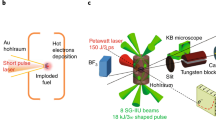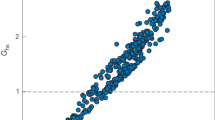Abstract
Recent progress in kilojoule-scale high-intensity lasers has opened up new areas of research in radiography, laboratory astrophysics, high-energy-density physics, and fast-ignition (FI) laser fusion. FI requires efficient heating of pre-compressed high-density fuel by an intense relativistic electron beam produced from laser–matter interaction. Understanding the details of electron beam generation and transport is crucial for FI. Here we report on the first visualization of fast electron spatial energy deposition in a laser-compressed cone-in-shell FI target, facilitated by doping the shell with copper and imaging the K-shell radiation. Multi-scale simulations accompanying the experiments clearly show the location of fast electrons and reveal key parameters affecting energy coupling. The approach provides a more direct way to infer energy coupling and guide experimental designs that significantly improve the laser-to-core coupling to 7%. Our findings lay the groundwork for further improving efficiency, with 15% energy coupling predicted in FI experiments using an existing megajoule-scale laser driver.
This is a preview of subscription content, access via your institution
Access options
Subscribe to this journal
Receive 12 print issues and online access
$209.00 per year
only $17.42 per issue
Buy this article
- Purchase on Springer Link
- Instant access to full article PDF
Prices may be subject to local taxes which are calculated during checkout




Similar content being viewed by others
References
Moses, E. Ignition on the National Ignition Facility: a path towards inertial fusion energy. Nucl. Fusion 49, 104022 (2009).
Hurricane, O. et al. Fuel gain exceeding unity in an inertially confined fusion implosion. Nature 506, 343–348 (2014).
Tabak, M. et al. Ignition and high gain with ultrapowerful lasers. Phys. Plasmas 1, 1626–1634 (1994).
Betti, R. et al. Shock ignition of thermonuclear fuel with high areal density. Phys. Rev. Lett. 98, 155001 (2007).
Atzeni, S. et al. Fast ignitor target studies for the HiPER project. Phys. Plasmas 15, 056311 (2008).
Kodama, R. et al. Fast heating of ultrahigh-density plasma as a step towards laser fusion ignition. Nature 412, 798–802 (2001).
Kodama, R. et al. Nuclear fusion: fast heating scalable to laser fusion ignition. Nature 418, 933–934 (2002).
Arikawa, Y. et al. A experimental study on the energy coupling efficiency from the heating laser to core plasma in the fast ignition experiment. Bull. Am. Phys. Soc. 58, BAPS.2013.DPP.YO5.1 (2013).
Theobald, W. et al. Initial cone-in-shell fast-ignition experiments on OMEGA. Phys. Plasmas 18, 056305 (2011).
Theobald, W. et al. Time-resolved compression of a capsule with a cone to high density for fast-ignition laser fusion. Nature Commun. 5, 5785 (2014).
Stoeckl, C. et al. A spherical crystal imager for OMEGA EP. Rev. Sci. Instrum. 83, 033107 (2012).
Marinak, M., Haan, S., Dittrich, T., Tipton, R. & Zimmerman, G. A comparison of three-dimensional multimode hydrodynamic instability growth on various National Ignition Facility capsule designs with HYDRA simulations. Phys. Plasmas 5, 1125–1132 (1998).
Radha, P. et al. Multidimensional analysis of direct-drive, plastic-shell implosions on OMEGA. Phys. Plasmas 12, 056307 (2005).
Akli, K. et al. Temperature sensitivity of Cu Kα imaging efficiency using a spherical Bragg reflecting crystal. Phys. Plasmas 14, 023102 (2007).
Pérez, F., Kemp, A., Divol, L., Chen, C. & Patel, P. Deflection of MeV electrons by self-generated magnetic fields in intense laser-solid interactions. Phys. Rev. Lett. 111, 245001 (2013).
Solodov, A. & Betti, R. Stopping power and range of energetic electrons in dense plasmas of fast-ignition fusion targets. Phys. Plasmas 15, 042707 (2008).
Solodov, A. A. et al. Simulations of fuel assembly and fast-electron transport in integrated fast-ignition experiments on OMEGA. Bull. Am. Phys. Soc. 58, BAPS.2013.DPP.YO5.3 (2013).
Strozzi, D. et al. Fast-ignition transport studies: realistic electron source, integrated particle-in-cell and hydrodynamic modeling, imposed magnetic fields. Phys. Plasmas 19, 072711 (2012).
Robinson, A., Key, M. & Tabak, M. Focusing of relativistic electrons in dense plasma using a resistivity-gradient-generated magnetic switchyard. Phys. Rev. Lett. 108, 125004 (2012).
Chawla, S. et al. Effect of target material on fast-electron transport and resistive collimation. Phys. Rev. Lett. 110, 025001 (2013).
Larson, D., Tabak, M. & Ma, T. Hybrid simulations for magnetized fast ignition targets and analyzing cone-wire experiments. Bull. Am. Phys. Soc. 55, BAPS.2010.DPP.JP9.119 (2010).
Jarrott, L. C. et al. Fast electron transport and spatial energy deposition in Cu-doped fast ignition plasmas. Bull. Am. Phys. Soc. 59, BAPS.2014.DPP.CI1.4 (2014).
Park, H.-S. et al. High-adiabat high-foot inertial confinement fusion implosion experiments on the National Ignition Facility. Phys. Rev. Lett. 112, 055001 (2014).
Crane, J. et al. Journal of Physics: Conference Series Vol. 244, 032003 (IOP Publishing, 2010).
McGuffey, C. et al. 9th Int. Conf. Inertial Fusion Sci. Appl. Vol. 9, 181 (2015).
Ivancic, S. et al. Channeling of multikilojoule high-intensity laser beams in an inhomogeneous plasma. Phys. Rev. E 91, 051101 (2015).
Welch, D., Rose, D., Cuneo, M., Campbell, R. & Mehlhorn, T. Integrated simulation of the generation and transport of proton beams from laser-target interaction. Phys. Plasmas 13, 063105 (2006).
Qiao, B. et al. Fast electron generation and transport from ten-picosecond laser-plasma interactions in the cone-guided fast ignition. Bull. Am. Phys. Soc. 58, BAPS.2013.DPP.YO5.5 (2013).
MacFarlane, J., Golovkin, I., Wang, P., Woodruff, P. & Pereyra, N. Spect3d—a multi-dimensional collisional-radiative code for generating diagnostic signatures based on hydrodynamics and pic simulation output. High Energy Density Phys. 3, 181–190 (2007).
Acknowledgements
This material is based on work supported by the US Department of Energy National Nuclear Security Administration under the National Laser User Facility programme with Award Number DE-NA0000854, DE-NA0002033, the OFES Fusion Science Center (FSC) grant No DE-FC02-04ER54789, the OFES ACE Fast Ignition grant No. DE-FG02-95ER54839, and NNSA cooperative agreement DE-NA0001944. The support of the DOE does not constitute an endorsement by the DOE of the views expressed in this article. J.J.S. participated in this work thanks to funding from the French National Agency for Research (ANR) and the competitiveness cluster Alpha—Route des Lasers through project TERRE ANR-2011-BS04-014. The authors would like to acknowledge excellent support provided by the Omega Laser Facility staff and the GA target fabrication group. The authors are thankful to S. Chawla for HYDRA simulations and C. Dorrer for the measured OMEGA-EP pre-pulse information.
Author information
Authors and Affiliations
Contributions
F.N.B. and M.S.W. designed and executed the experiment as principal investigators with help from L.C.J., C.McGuffey, W.T., A.A.S., R.B., J.D., M.H.K., F.J.M., H.S.M., P.K.P., J.J.S., H.S., T.Y. and R.B.S.; C.S., H.C., T.D., V.Y.G., H.H., T.I. and C.Mileham developed and operated diagnostics; data analysis was performed by L.C.J., C.McGuffey and W.T.; simulations were performed by A.A.S. for the DRACO/LSP modelling, B.Q. for the LSP PIC modelling, L.C.J. for the ZUMA modelling; targets were manufactured by E.M.G., R.W.L. and R.B.S.; M.S.W., C.McGuffey and F.N.B. led the writing of the manuscript with significant contributions from A.A.S., L.C.J., W.T., H.S.M. and R.B.S.; figures were prepared by L.C.J., A.A.S. and M.S.W.
Corresponding authors
Ethics declarations
Competing interests
The authors declare no competing financial interests.
Supplementary information
Supplementary information
Supplementary information (PDF 878 kb)
Rights and permissions
About this article
Cite this article
Jarrott, L., Wei, M., McGuffey, C. et al. Visualizing fast electron energy transport into laser-compressed high-density fast-ignition targets. Nature Phys 12, 499–504 (2016). https://doi.org/10.1038/nphys3614
Received:
Accepted:
Published:
Issue Date:
DOI: https://doi.org/10.1038/nphys3614
This article is cited by
-
High-flux bright x-ray source from femtosecond laser-irradiated microtapes
Communications Physics (2024)
-
Enhanced energy coupling for indirect-drive fast-ignition fusion targets
Nature Physics (2020)
-
Direct observation of imploded core heating via fast electrons with super-penetration scheme
Nature Communications (2019)
-
Time-resolved measurements of fast electron recirculation for relativistically intense femtosecond scale laser-plasma interactions
Scientific Reports (2018)
-
Magnetized fast isochoric laser heating for efficient creation of ultra-high-energy-density states
Nature Communications (2018)



